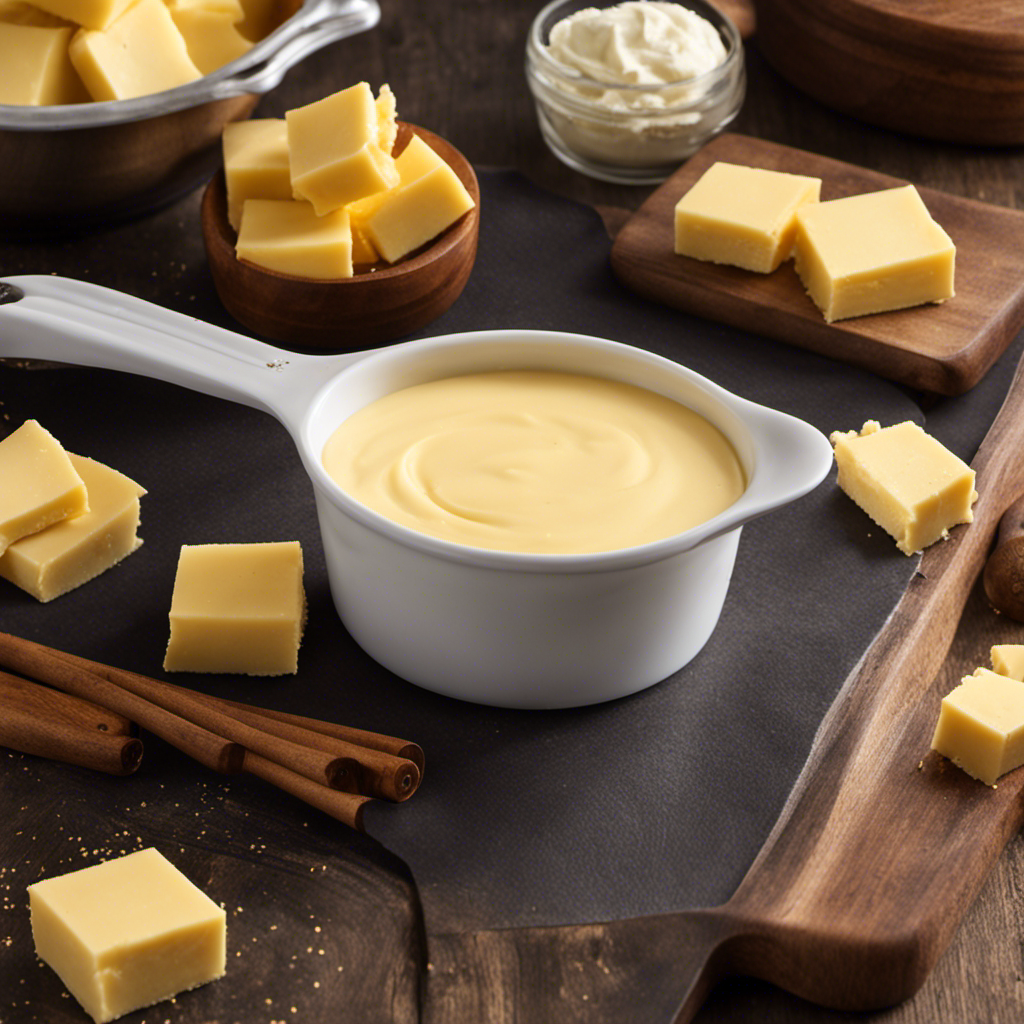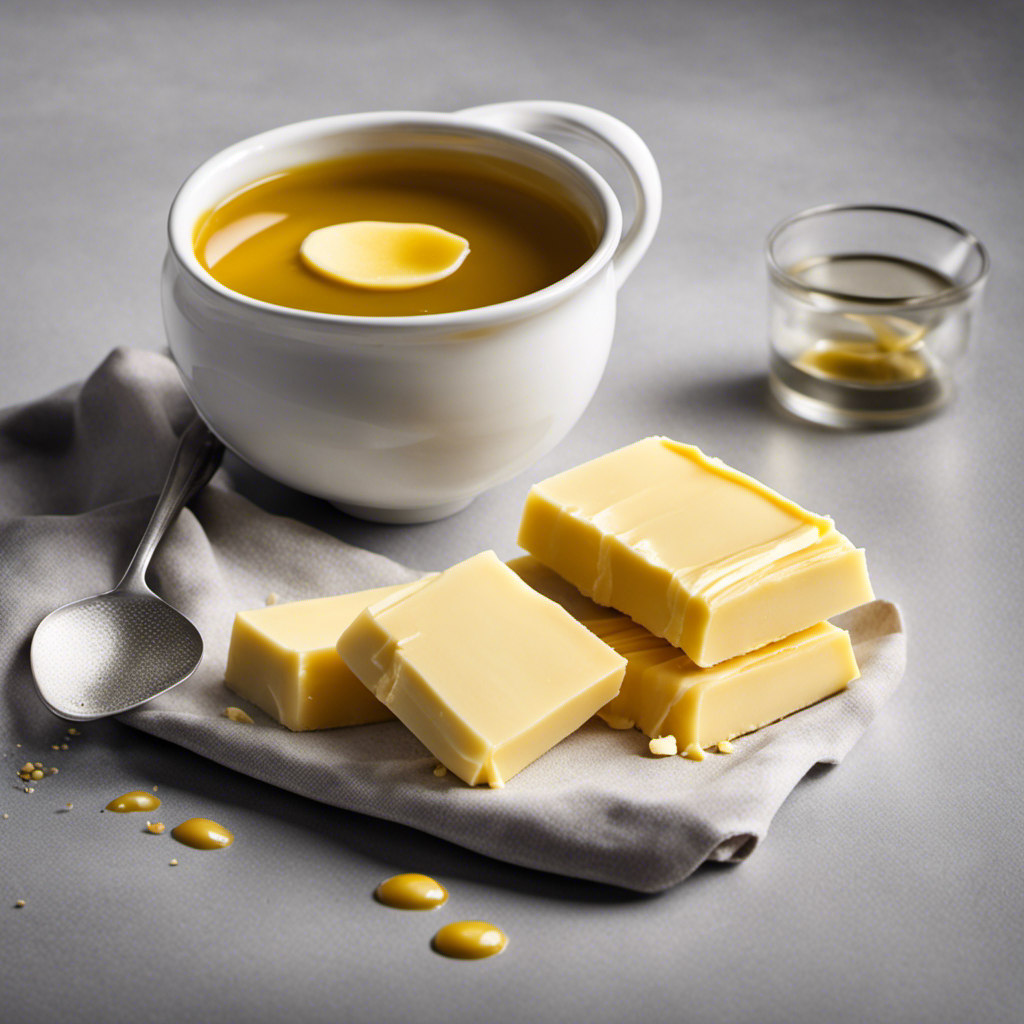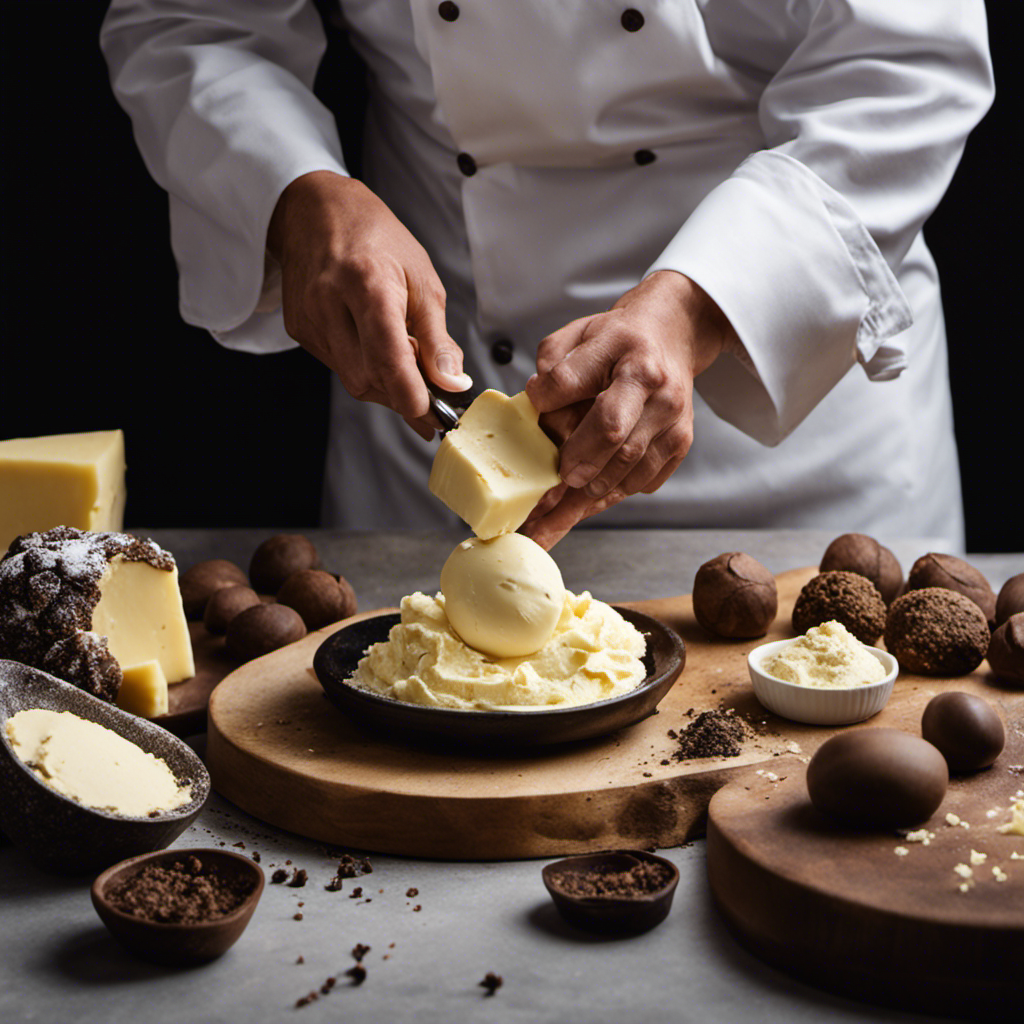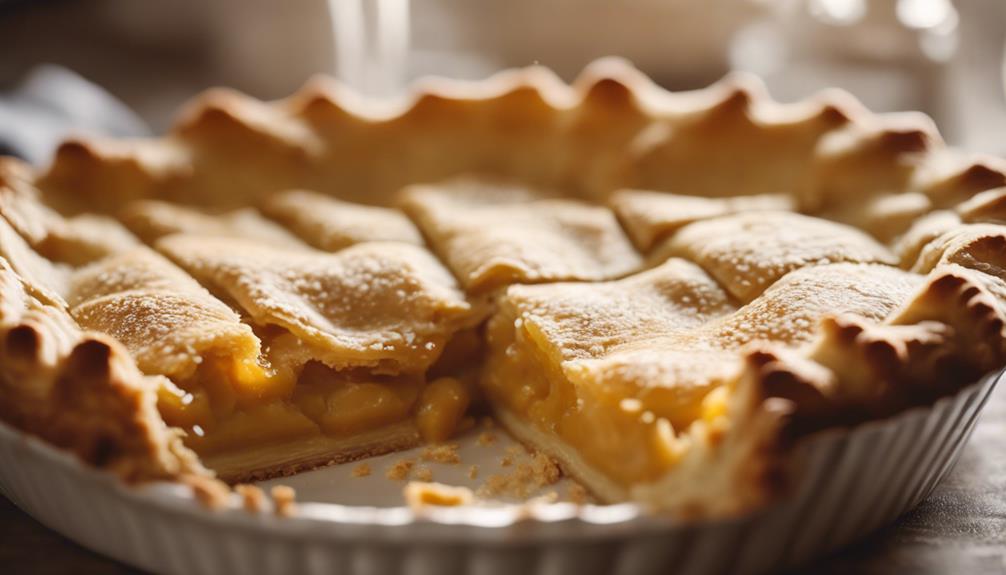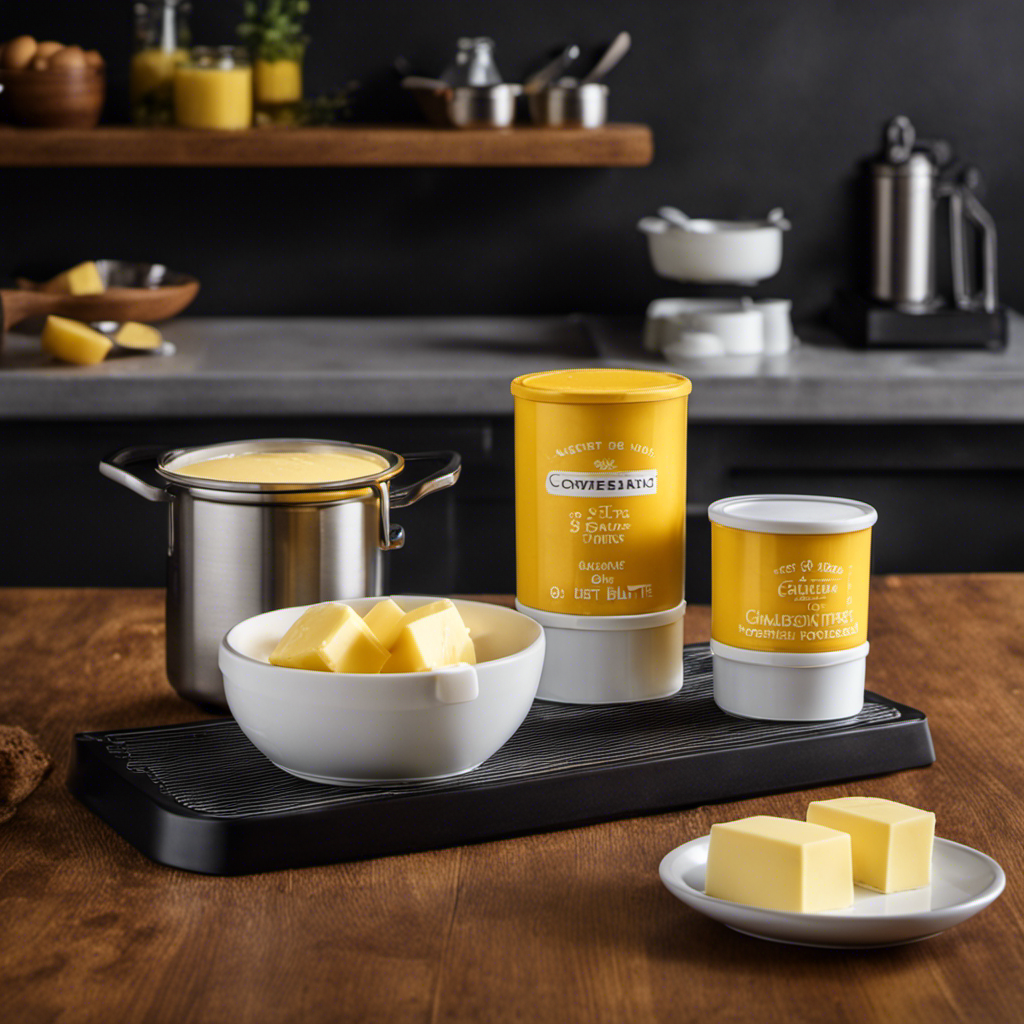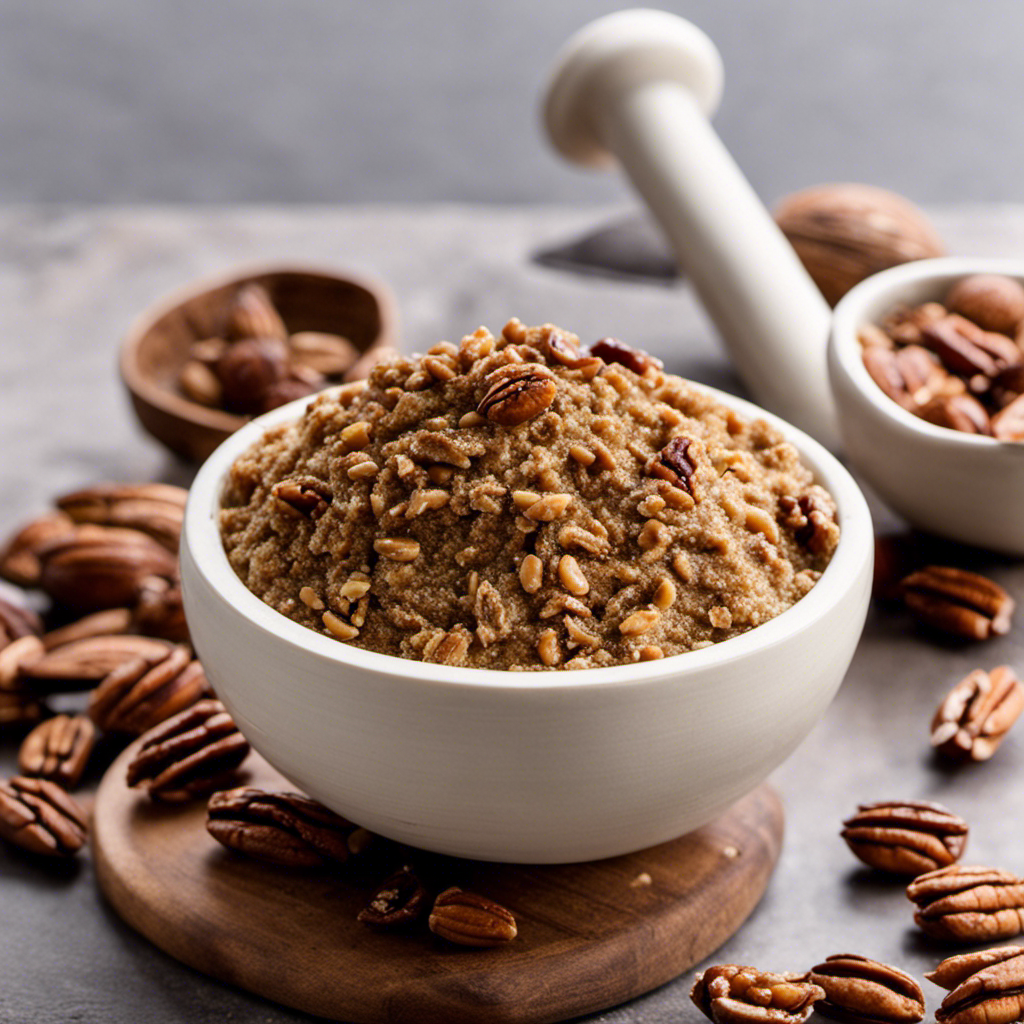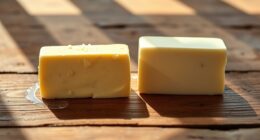As someone who loves to cook and bake, I often find myself reaching for the measuring cups and spoons to ensure precise and delicious results.
But what happens when a recipe calls for a third cup of butter? How much exactly is that?
In this article, I’ll guide you through the world of butter measurements, teach you how to convert them to grams or ounces, share some tips and tricks for baking with a third cup of butter, and even provide you with mouthwatering recipes that call for this precise amount.
So, let’s dive in and demystify the third cup of butter.
Key Takeaways
- A third cup of butter is equal to about 5 and 1/3 tablespoons.
- A third cup of butter weighs approximately 76 grams or around 2.7 ounces.
- Precision in butter measurements is crucial for baking or cooking.
- Softening butter and using substitutes like mashed bananas or Greek yogurt can be helpful when baking with a third cup of butter.
Butter Measurements: Understanding Third Cup Measurements
A third cup of butter is equal to about 5 and 1/3 tablespoons. When it comes to converting butter measurements, it’s important to understand the equivalents.
Butter is typically sold in sticks or in cups, and it’s helpful to know how to convert between the two. One stick of butter is equivalent to half a cup or 8 tablespoons. So, if a recipe calls for a third cup of butter, you can simply divide one stick of butter into three equal parts, each part being a third cup.
This knowledge is essential in baking or cooking, as precise measurements can make or break a recipe. Understanding butter measurement equivalents allows you to confidently adjust recipes and create delicious dishes.
Converting Third Cup Measurements: Butter to Grams or Ounces
When it comes to baking, accurate measurements are crucial for achieving the desired results. One common measurement that can be a bit confusing is converting a third cup of butter to grams or ounces.
In this discussion, I will explore various conversion methods and their accuracy, so you can confidently convert butter measurements and ensure your recipes turn out perfectly every time.
Butter Weight Conversions
To convert the weight of butter, you’ll need to know how much a third cup of butter weighs. This is quite important when it comes to following recipes accurately.
Here are a few butter weight conversion methods and some common recipes that use a third cup of butter:
-
Grams: A third cup of butter weighs approximately 76 grams. This measurement is commonly used in European recipes.
-
Ounces: In the United States, a third cup of butter weighs around 2.7 ounces. This measurement is often used in American recipes.
-
Cookies: Many cookie recipes call for a third cup of butter. It lends a rich, buttery flavor and helps create a soft and chewy texture.
-
Cake Frosting: Buttercream frosting, a staple in cake decorating, often requires a third cup of butter to achieve a smooth and creamy consistency.
Knowing the weight of a third cup of butter will ensure your recipes turn out just right, so you can enjoy delicious treats every time.
Accuracy of Conversion Methods
Grams and ounces are two common conversion methods used to accurately measure the weight of butter in different recipes. When it comes to baking or cooking, precision is key, especially when it comes to ingredients like butter.
Butter conversion methods ensure that the correct amount of butter is used, resulting in the perfect texture and taste of the dish. Accuracy is crucial because even a slight variation in the amount of butter can significantly affect the final outcome.
Whether you prefer using grams or ounces, it’s essential to follow the recipe’s instructions and convert the measurement accurately. Using a digital kitchen scale can help ensure precise measurements.
Baking With a Third Cup of Butter: Tips and Tricks
If you’re baking with a third cup of butter, here are some tips and tricks you can try.
-
Softening Techniques: To ensure your butter is soft and easily mixable, leave it out at room temperature for about 30 minutes before using. Alternatively, you can microwave it for a few seconds or grate it using a cheese grater.
-
Measuring Accurately: To measure a third cup of butter, use a measuring cup specifically designed for liquids. Fill it to the brim, making sure the butter is level with the top. Scrape off any excess using a straight-edged utensil.
-
Substitution Options: If you’re looking to cut down on saturated fats, you can substitute a third cup of butter with alternatives like mashed bananas, applesauce, or Greek yogurt. These options provide moisture and flavor without the added fat.
-
Creaming Method: When using a third cup of butter in recipes that require creaming, ensure the butter is at the right temperature. It should be soft but not melted. This will allow the butter to incorporate air, resulting in a light and fluffy texture.
With these tips and tricks, you’ll be able to confidently bake using a third cup of butter. Now, let’s explore some delicious ideas to try with this measurement.
Recipes That Call for a Third Cup of Butter: Delicious Ideas to Try
When it comes to baking or cooking, butter is often a key ingredient. However, there are times when you may not have butter on hand or may need to convert the measurement in a recipe.
In this discussion, we will explore alternative butter substitutes and provide helpful tips on butter measurement conversions, ensuring that you can still create delicious dishes without missing a beat.
Alternative Butter Substitutes
Are you looking for alternative butter substitutes? Well, you’re in luck! There are plenty of options out there that not only taste great but also come with added health benefits. Here are four butter alternatives that will surely satisfy your cravings:
-
Avocado Spread: Creamy and rich, avocado spread is a delicious substitute for butter. Packed with healthy fats and essential nutrients, it not only adds a silky texture to your dishes but also provides numerous health benefits.
-
Coconut Oil: Known for its tropical flavor, coconut oil is a versatile substitute for butter. It contains medium-chain fatty acids that are easily metabolized by the body, making it a great choice for those looking to boost their energy levels.
-
Greek Yogurt: Creamy and tangy, Greek yogurt can be used as a replacement for butter in baking recipes. It adds moisture and richness to your dishes while also providing a good source of protein and probiotics.
-
Nut Butter: Whether it’s almond butter, peanut butter, or cashew butter, nut spreads are a tasty alternative to butter. They are packed with healthy fats, vitamins, and minerals, making them a great choice for both savory and sweet dishes.
Butter Measurement Conversions
Now that we’ve explored alternative butter substitutes, let’s dive into the world of butter measurement conversions. As a baking enthusiast, I often come across recipes that call for a third cup of butter. But what exactly does that mean in terms of tablespoons? To make things easier, I’ve put together a handy table below that showcases the butter measurement equivalents.
| Butter Measurement Equivalents | |
|---|---|
| 1/3 cup of butter | 5 1/3 tablespoons |
| 2/3 cup of butter | 10 2/3 tablespoons |
| 1 cup of butter | 16 tablespoons |
Converting a third cup of butter to tablespoons is not as complicated as it seems. Simply multiply the number of cups by 16, which gives you the total number of tablespoons. So, a third cup of butter is equivalent to 5 1/3 tablespoons. Armed with this knowledge, you can confidently tackle any recipe that calls for butter measurements. Happy baking!
Substituting a Third Cup of Butter: Healthy Alternatives to Consider
There’s a variety of healthy alternatives to consider when substituting a third cup of butter. Here are four options that not only provide great taste but also offer various health benefits:
-
Avocado: Creamy and packed with healthy fats, mashed avocado can be a perfect replacement for butter in baking or spreading on toast.
-
Greek yogurt: With its tangy flavor and creamy texture, Greek yogurt works well in recipes that call for butter. It adds moisture without the extra fat.
-
Coconut oil: This tropical oil adds a delicious hint of coconut flavor to dishes and is a great substitute for butter in both sweet and savory recipes.
-
Applesauce: When baking, applesauce can be used to replace butter for a lower fat and calorie option. It also adds natural sweetness and moisture to your baked goods.
By incorporating these butter substitutes into your cooking and baking, you can enjoy the health benefits they offer while still indulging in delicious treats.
Now, let’s move on to the next topic: storing leftover butter and how to properly save a third cup.
Storing Leftover Butter: How to Properly Save a Third Cup
To properly save a leftover amount, you can seal it in an airtight container and refrigerate it for future use. This simple step not only ensures the freshness of the butter but also helps in saving time and minimizing waste.
When it comes to storing leftover butter, it’s important to remember a few key points. First, make sure the container is airtight to prevent any odors from seeping in and altering the taste. Second, refrigeration is essential to keep the butter from spoiling. Lastly, label the container with the date to keep track of its freshness.
Frequently Asked Questions
Can I Use Margarine Instead of Butter in Recipes That Call for a Third Cup of Butter?
Yes, you can use margarine instead of butter in recipes that call for a third cup of butter. Margarine is a common and suitable substitution for butter, providing a similar texture and flavor to your dish.
How Many Tablespoons Are in a Third Cup of Butter?
In cooking conversions, knowing how many tablespoons are in a third cup of butter is essential. It helps when substituting with butter substitutes like margarine. Let me share the answer with you.
What Is the Calorie Content of a Third Cup of Butter?
The calorie content of a third cup of butter is approximately 715 calories. However, if you’re looking for vegan alternatives, there are options like coconut oil or plant-based margarine that can be used instead.
Can I Freeze Leftover Butter After Measuring Out a Third Cup?
Freezing butter for long term storage is a great way to keep it fresh. As for substituting oil for butter in recipes requiring a third cup, it can be done, but the texture and taste might be slightly different.
Are There Any Vegan Alternatives to Butter That Can Be Used in Recipes Requiring a Third Cup of Butter?
There are many vegan butter alternatives and butter substitutes available that can be used in recipes requiring a third cup of butter. These options provide a plant-based alternative while still maintaining the desired texture and flavor.
Conclusion
In conclusion, understanding the measurements of a third cup of butter is essential for any baking enthusiast. By converting these measurements to grams or ounces, you can ensure precise and delicious results in your recipes.
Additionally, incorporating tips and tricks for baking with a third cup of butter can elevate your culinary creations. Don’t be afraid to explore the vast array of recipes that call for a third cup of butter, as they can provide delightful culinary adventures.
And remember, storing leftover butter properly is crucial for maintaining its freshness. So, seize the opportunity to embrace the wonders of a third cup of butter and let your baking skills soar! As the saying goes, ‘Butter makes everything better.’
